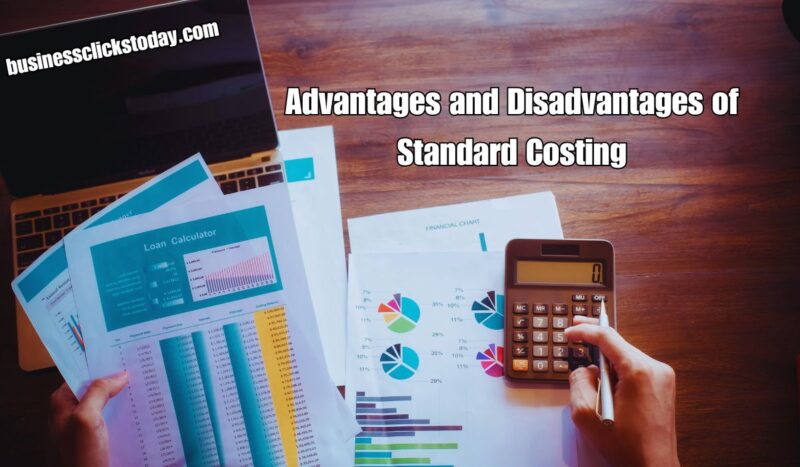When running a business that manufactures or produces goods in-house, it’s crucial to have a good understanding of the cost to produce those goods before starting the manufacturing process. This is where standard costing comes into play. Essentially, standard costing allows businesses to estimate the expected costs of production, helping them to create budgets and make informed financial decisions. By understanding the advantages and disadvantages of standard costing, companies can decide if this method is suitable for their financial strategies. In this article, we will explore the potential benefits and drawbacks of standard costing.
What is Standard Costing?
Standard costing is an accounting technique used to determine the estimated costs of production before actual manufacturing begins. It involves calculating the expected expenses, such as materials, labor, and overheads, required to manufacture a product. This method provides businesses with a financial framework to control costs, compare actual expenses against predicted costs, and make necessary adjustments.
| Aspect | Advantages of Standard Costing | Disadvantages of Standard Costing |
| Cost Control | – Provides benchmarks for cost comparison and control. | – May lead to complacency if actual costs consistently meet standards. |
| Performance Analysis | – Facilitates performance evaluation by comparing actual costs to standards. | – Requires frequent updates of standards, which can be time-consuming. |
| Decision Making | – Helps identify inefficiencies and areas for improvement. | – May lead to cost distortion if standards are set inaccurately. |
| Planning | – Simplifies budgeting and forecasting processes with predetermined costs. | – Can create tension among employees if they feel unfairly blamed. |
| Employee Behavior | – Encourages cost-consciousness among employees striving to meet standards. | – May overlook qualitative factors and focus solely on quantitative ones. |
Advantages of Standard Costing
1. Controlling Costs
One of the major advantages of standard costing is its ability to help businesses keep track of their expenses. By comparing actual costs with predetermined standard costs, companies can identify areas where they are overspending and take corrective measures. This method acts like a financial health check, ensuring that costs stay within the planned budget, much like reviewing a shopping receipt to catch any unexpected overspending.
2. Better Budgeting
Standard costing is an essential tool for accurate budgeting. With the ability to estimate production costs in advance, businesses can create more precise budgets and set financial goals. This proactive approach to budgeting ensures better cash flow management, reduces the likelihood of unexpected financial deficits, and contributes to the overall financial stability of the business.
3. Improved Decision-Making
The standard costing method provides managers with valuable insights into the business’s financial performance. By understanding cost variances, management can make well-informed decisions regarding resource allocation, pricing strategies, and production adjustments. This informed decision-making process allows companies to optimize their operations, ensuring maximum profitability.
4. Enhancing Employee Accountability and Motivation
Standard costing can also enhance employee responsibility by providing clear performance benchmarks. Setting specific cost and performance targets encourages employees to work efficiently and meet established goals. Moreover, it can motivate staff to perform better, as they are more aware of the company’s financial expectations and their role in controlling costs.
5. Efficient Inventory Management
Managing inventory can be a challenge for businesses, but standard costing simplifies this process. By assigning a predetermined cost to each item of inventory, businesses can efficiently track stock levels and evaluate inventory value. This systematic approach reduces the complexity of inventory management, ensuring that businesses maintain optimal stock levels without over- or under-ordering.
6. Facilitating Policy and Pricing Decisions
Standard costing provides a solid foundation for businesses when establishing pricing and production policies. With a clear understanding of production costs, companies can make informed decisions about product pricing, ensuring competitiveness in the market while maintaining profitability. In highly competitive markets like India, this can be especially important for businesses looking to stand out while controlling costs.
7. Performance Evaluation
Standard costing allows companies to measure actual performance against predicted outcomes. This comparison provides a realistic view of how the business is performing financially. Managers can easily identify areas where the company is excelling or falling short, enabling them to make strategic adjustments to improve overall performance.
Disadvantages of Standard Costing
While standard costing has several benefits, it also comes with its challenges. Let’s examine the potential downsides of using this method.
1. Difficulty Adapting to Rapid Market Changes
One of the main disadvantages of standard costing is its inability to keep up with rapidly changing market conditions. In industries where prices fluctuate frequently, such as raw materials or labor costs, standard costing may not accurately reflect the true cost of production. As a result, the business may rely on outdated cost figures, leading to poor financial decisions and inaccurate budgeting.
2. High Setup Costs
Implementing a standard costing system can be expensive and time-consuming. The process requires thorough analysis, data collection, and system setup, which can be a significant investment, especially for smaller businesses with limited resources. For many companies, the initial costs of implementing this system may outweigh the benefits, making it a less attractive option for businesses on a tight budget.
3. Complexity and Risk of Becoming Outdated
Standard costing systems can be complex to set up and maintain. Employees may struggle to understand how the system works, which can lead to confusion and errors. Additionally, as technology and market conditions evolve, a once-effective standard costing system may become outdated, requiring further investment in updates or new systems to stay relevant.
4. Challenges in Setting Accurate Standards
Establishing accurate standard costs requires a deep understanding of both the business’s operations and the market conditions. If the standards are set too high or too low, the resulting cost analysis may be inaccurate, leading to poor decision-making. Incorrect standards can create inefficiencies and prevent businesses from optimizing their resources effectively.
5. Delayed Feedback and Lack of Granularity
Standard costing typically provides feedback only after the production cycle is complete, making it difficult to make real-time adjustments. This delay can result in missed opportunities to correct inefficiencies during the production process. Additionally, standard costing may not capture the finer details of individual unit costs, which can be crucial for businesses that need to make quick, precise decisions.
6. Limited Use for Custom or Unique Products
Standard costing works best for businesses that produce large quantities of standardized products. However, for businesses that specialize in custom or unique items, it can be difficult to establish a standard cost for each product. In industries that rely on personalized or bespoke production, standard costing may not provide accurate or useful financial data, making it less suitable for businesses with diverse product lines.
Conclusion
While standard costing offers numerous benefits, such as improved cost control, better budgeting, and enhanced decision-making, it also has its limitations. Businesses in rapidly changing markets or those with unique product offerings may find that the disadvantages of standard costing, such as its complexity and inability to adapt to market changes, outweigh its benefits. Ultimately, companies should carefully weigh the advantages and disadvantages of standard costing to determine if it is the right fit for their financial and operational needs. Understanding these pros and cons will enable businesses to make informed decisions that support long-term growth and success.
















